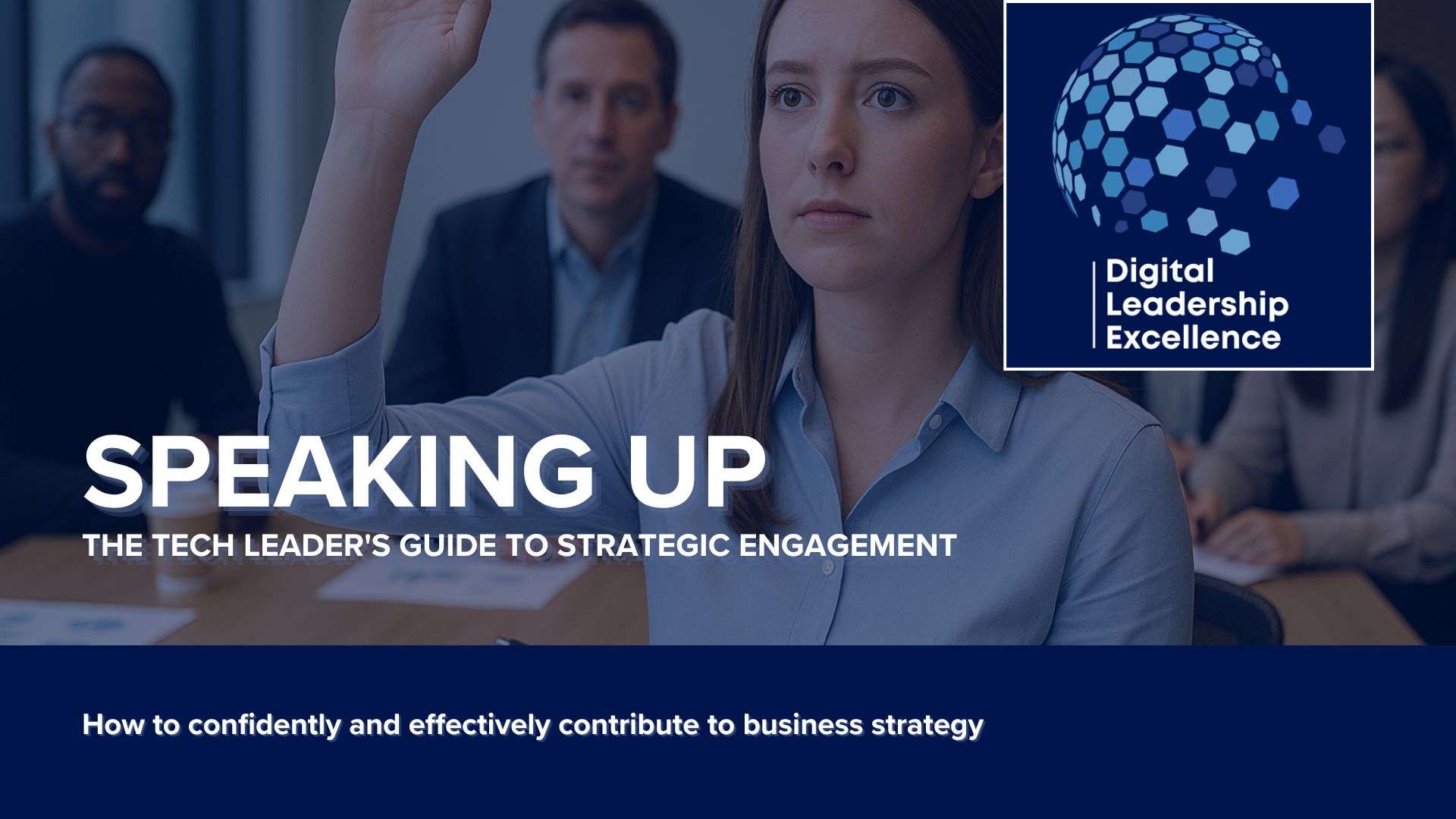Greetings, and welcome to Digital Leadership Excellence — Your trusted weekly guide to excelling in tech leadership, delivering results, and thriving with clarity and purpose. In every issue, we provide insights into winning strategies, growth tactics, and practical solutions, designed to support both current and aspiring technology leaders navigating the ever-evolving digital world.
1.0 Introduction
The executive meeting started like most others.
Budget review. Performance metrics. Then the conversation shifted to something that made most technology leaders uncomfortable.
Market expansion strategy.
The CEO laid out the challenge. The company wanted to enter a new vertical, but the sales cycle was longer than expected and customer acquisition costs were eating into projected margins.
Around the table, executives started weighing in.
The CFO talked about cash flow implications. The CMO discussed positioning challenges. The Head of Sales explained why enterprise deals in this sector required different approaches.
And the VP of Infrastructure sat silent.
Not because he had nothing to contribute. His platform could scale to support the expansion. His team had experience with similar customer profiles. He'd even identified technical capabilities that could differentiate the offering.
But he stayed quiet.
Because the conversation wasn't about technology. It was about business strategy. And he'd convinced himself that speaking up would expose him as someone who didn't understand business well enough to deserve a seat at that table.
Six months later, when the CIO role opened up, he wasn't considered.
The feedback? "Too technical. Doesn't think strategically about the business."
This pattern shows up everywhere.

Technology leaders who are brilliant at their jobs. Who run high-performing teams. Who deliver results consistently.
But who go silent the moment conversations shift from implementation to strategy.
They tell themselves they're being thoughtful. Respectful. Waiting for the right moment to contribute.
What they're actually doing is confirming to everyone in the room that they don't belong at the executive level.
Because here's what research on executive presence reveals.
Strategic credibility isn't demonstrated through perfect answers. It's demonstrated through intelligent engagement with business challenges—even when you're still learning.
The technology leaders who advance to C-suite roles aren't necessarily more knowledgeable about business than their peers.
They're more willing to participate in business conversations. To ask questions. To connect technology capabilities to strategic outcomes. To engage with uncertainty instead of hiding from it.

Let's be direct about what's actually happening when you stay silent in business discussions.
You're not protecting yourself from looking uninformed. You're defining yourself as someone who only thinks tactically about technology—not strategically about the business.
Every executive in that room notices your silence. And they draw conclusions from it.
Not that you're humble or thoughtful. That you don't understand how the business works. That you can't connect technology to outcomes. That you're not ready for the next level.
Your silence has a cost. And that cost is your career advancement.
So how do you shift from strategic silence to strategic engagement without pretending to be an expert in areas where you're still learning?
You start by understanding what strategic engagement actually looks like.
It's not about having all the answers. It's not about competing with the CFO on financial analysis or the CMO on market positioning.
Strategic engagement is about demonstrating that you think beyond your technical domain. That you understand technology exists to serve business outcomes. That you can connect capabilities to challenges.
Here's the framework:
2.0 The Strategic Engagement Framework
There are three types of contributions you can make in any business discussion—even when you're not the subject matter expert.
First: The Connecting Question
This is where you link the business challenge being discussed to technology capabilities or constraints.
When the CFO talks about margin pressure, you ask: "What are the primary cost drivers—is it customer acquisition, retention, or operational efficiency? Because each of those has different technology implications."
When the CMO discusses customer experience challenges, you explore: "What part of the customer journey is creating the most friction? That helps me understand where technology can make the biggest impact."
When the CEO mentions competitive threats, you inquire: "What capabilities are competitors using to differentiate? Are those technology-driven or business model innovations?"
These questions don't require you to be a finance expert, marketing guru, or strategy consultant.
They require you to be curious about business challenges and willing to explore how technology connects to outcomes.
Second: The Perspective Offer
This is where you share what you're observing from your vantage point—without claiming to have the complete answer.
"From the technology side, I'm seeing implementation complexity driving longer sales cycles in enterprise deals. That might be contributing to the customer acquisition cost challenge."
"Our platform data shows usage patterns dropping off at a specific point in the customer journey. That could be connected to the retention issues being discussed."
"Competitors in this space are using automation to reduce operational costs. We have similar capabilities that aren't being fully leveraged."
You're not solving the entire business problem. You're offering a technology lens that adds dimension to the strategic conversation.
Third: The Capability Connection
This is where you explicitly link technology investments or initiatives to the business outcomes being discussed.
"If reducing customer acquisition costs is the priority, our API platform could enable partner integrations that create new distribution channels."
"The customer experience improvements we've been discussing aren't just nice-to-have features. Based on what I'm hearing about retention challenges, they could directly impact our recurring revenue."
"The infrastructure modernization we've proposed would reduce our cost to serve by 30%. That connects directly to the margin pressure conversation."
You're demonstrating that you don't just think about technology in isolation. You understand how technical decisions drive business results.
3.0 Fear Paralysis
Now here's what stops most technology leaders from using this framework.
Fear.
Fear of saying something wrong. Fear of looking uninformed. Fear of being exposed as "not business-savvy enough."
So let's address that fear directly.
You will sometimes ask questions that reveal gaps in your business knowledge. You will occasionally offer perspectives that don't land perfectly. You will connect technology to outcomes in ways that need refinement.
That's not a problem. That's called learning.
And here's what research on executive development shows: The leaders who advance are the ones willing to learn in public, not the ones who wait until they've achieved private mastery.
Every time you ask a connecting question, you're building business acumen in real time. Every time you offer a perspective, you're developing strategic thinking through practice. Every time you link technology to outcomes, you're strengthening the capability that separates tactical leaders from executive ones.
The technology leaders who stay stuck? They're waiting for permission to be perfect before they participate.
The ones who advance understand that strategic credibility comes from engagement, not flawlessness.

Let's make this practical.
Think about the last executive meeting you attended where business strategy was discussed. Maybe it was about revenue growth, competitive positioning, customer retention, operational efficiency, or market expansion.
Now ask yourself: How many times did you speak? What did you contribute?
If your answer is "I mostly listened" or "I only spoke when the topic was technical," you've identified the pattern keeping you stuck.
Here's your practice framework for the next business discussion you're part of.
Before the meeting: Review the agenda. Identify one business challenge that will likely be discussed. Prepare one connecting question that links that challenge to technology.
Not a perfect question. Just an engaged one.
During the meeting: When the business challenge comes up, ask your question. Don't wait for the perfect moment. Don't overthink it. Just participate.
After the meeting: Notice what happened. Did your question add value? Did it spark discussion? Did it reveal something you need to learn more about?
The goal isn't to be brilliant. The goal is to be engaged.
Do this consistently, and something shifts.
You stop being the technology leader who only speaks about implementation. You become the technology leader who connects capabilities to strategy.
And that shift is exactly what opens C-suite doors.
Let's address the objection I hear most often.
"But I don't want to fake knowledge I don't have. I don't want to pretend to be a business expert when I'm still learning."
Good. Don't.
Strategic engagement isn't about faking expertise. It's about demonstrating curiosity, business awareness, and the ability to connect your domain to outcomes.
You're not claiming to be the CFO. You're offering the technology perspective that the CFO needs to make better decisions.
You're not pretending to be the CMO. You're connecting technology capabilities to the customer experience challenges the CMO is trying to solve.
You're not competing with the CEO. You're supporting the CEO's strategic priorities with technology insights they can't see from their vantage point.
That's not fake. That's executive-level thinking.

Here's the bottom line.
Your technical expertise got you to Director or VP. But it won't get you to the C-suite.
What will get you there is the ability to engage with business strategy. To ask connecting questions. To offer technology perspectives. To link capabilities to outcomes.
And the only way to develop that ability is through practice.
Not perfect practice. Just consistent engagement.
The next time you're in a meeting where business strategy is being discussed, you have a choice.
You can stay silent, protect yourself from potential mistakes, and confirm to everyone in the room that you're not ready for the next level.
Or you can ask one question. Offer one perspective. Make one connection between technology and business outcomes.
That single act of engagement won't transform your career overnight.
But do it consistently, and you'll notice something change.
The executives around you start asking for your input. They begin to see you as someone who thinks strategically, not just tactically. They start considering you for conversations and opportunities you were previously excluded from.
That's how you stop being the technical expert in the room and start being seen as the strategic leader who happens to have deep technical expertise.
Your silence isn't protecting you. It's defining you.
Start speaking up. Not perfectly. Just strategically.
That's the shift that changes everything.
4.0 Your Next Move
Think about the next business meeting on your calendar. What's one connecting question you could ask that links the business challenge to technology capabilities?
Write it down. Practice saying it out loud. Then use it.
That's how you move from strategic silence to strategic engagement.
One question at a time.
Robert



